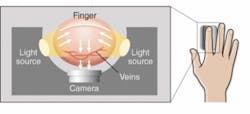Biometrics: Vein scanning improves door, car, and computer security
Biometric identification methods such as fingerprinting, voice authentication, face recognition, and iris scanning all have pros and cons in terms of their ease of use and level of security. Because each of these physiological features—fingertip, voice, face, eye—is intricate, the equipment needed to distinguish and authenticate them requires complex hardware, software, or both. The resulting bulk and cost has restricted the use of biometrics to stationary applications such as personal computers, automatic teller machines (ATMs), and selective door locks.
Near-infrared vein scanning (also known as vascular patterning) has emerged as a more-secure biometric method that improves authentication speed and false-rejection/acceptance rates. Fujitsu (Tokyo, Japan) was the first to market with its palm vein-scanning technology (2004); Bionics America (Los Angeles, CA) and Hitachi (Tokyo) have focused on developing and commercializing finger-vein scanning; and TechSphere (Seoul, Korea), through its Canadian partner Identica (Toronto, Canada), has the corner on back-of-the-hand vein scanning. Unlike fingerprinting and other forms of biometrics, vein scanning is the only privacy-enhancing biometric technique, according to Chuck Wilson, deputy general manager of the Hitachi Security Solutions Group within Hitachi America. With voice, face, fingerprints, and even eyes, he points out, the body parts are external and thus can be more easily seen, recorded, and potentially forged. But vein authentication scans the interior of the body, making forgery extremely difficult. It is also less expensive than iris scanning and face/voice recognition, and the false rejection rate is significantly lower than fingerprinting.
Hitachi, which has been working on finger-vein authentication since 1997, claims 23 patents surrounding this technology. The company uses infrared LEDs and a CCD camera to scan and image the vein pattern in the middle section of a finger and compare it to the database associated with the application assigned to that finger, thus verifying the identity of the individual. Multiple applications with a single device are possible because each finger on a person’s hand could be used to authorize a different transaction or event.
When a finger is placed on the Hitachi device, which measures just 59 mm high × 74 mm wide, near-IR light is transmitted through the skin and partially absorbed by hemoglobin in the blood without interference from wrinkles, lines, roughness, dryness, or other imperfections on the surface of the skin (see figure). A CCD camera (which uses a small, rectangular piece of silicon to receive incoming light) captures the image of the vein pattern through this reflected light. Image processing constructs a finger vein pattern from the camera image. The veins appear as shadows or dark areas in the CCD image. Using a proprietary image-processing algorithm, the image is then transformed into a high-contrast vein pattern profile that is compressed and digitized so it can be registered as a template of a person’s biometric authentication data.
Potential markets
Like its competitors, Hitachi is initially targeting door/building access, computers, and ATMs with this technology. According to Wilson, 92% of the financial institutions in Japan have adopted finger-vein biometric validation devices in their ATMs. The company also sees great potential in the automotive market. In 2005, Hitachi introduced a grip-type finger-vein authentication capability that enabled a car door to be opened simply by grasping the handle. Since then the company has been pursuing several other automotive applications, including adjusting car seats, air conditioners, and mirrors; preventing car theft; and authorizing automatic in-vehicle payment for food at a drive-through or for music downloads for a car audio system. Last year, for example, Hitachi introduced finger-vein authentication technology to authorize driver verification in a fraction of a second just by gripping the steering wheel, and by 2010 the company expects finger-vein scanners to begin replacing traditional key-based car ignitions.
Other more-personalized applications are emerging as well. Earlier this year Fukui Computer (Fukui, Japan) unveiled a line of networked exercise machines equipped with Hitachi finger vein readers. When users identify themselves with a simple press of the finger, the machines respond by automatically adjusting the weight resistance and seat position based on the user’s previously set preferences. The machines also connect to a remote server to retrieve the user’s personal exercise data—including previous exercise records and stats, training regimens, and calorie consumption data—and display it on a touch screen to help guide their workout.
About the Author
Kathy Kincade
Contributing Editor
Kathy Kincade is the founding editor of BioOptics World and a veteran reporter on optical technologies for biomedicine. She also served as the editor-in-chief of DrBicuspid.com, a web portal for dental professionals.
